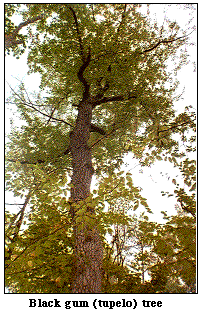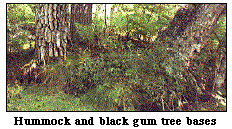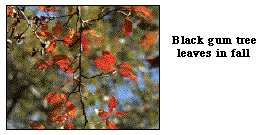The black gum tree (Nyssa sylvatica) is a hardwood in the tupelo family which may grow up to 75-80 feet tall. Amazingly, these trees live beyond 400 years! The general distribution of black gums is from southwestern Maine, west to southern Ontario, New York, Michigan, Illinois and Missouri, and south to Florida.
 Black gum trees, like
the Atlantic white cedar, prefer the acid content of swamps. Other
constituents of swamps where black gum trees are located often
include red maple, yellow birch. and white pine, as well as a variety
of shrubs and ferns. While the branches of the black gum tree grow
generally perpendicular to the trunk , they lack symmetry in their
arrangement. The tree bark ranges from reddish brown to steel gray .
As the tree ages, the bark develops deep irregular ridges and diamond
shaped plates that resemble the scales of an alligator.
Black gum trees, like
the Atlantic white cedar, prefer the acid content of swamps. Other
constituents of swamps where black gum trees are located often
include red maple, yellow birch. and white pine, as well as a variety
of shrubs and ferns. While the branches of the black gum tree grow
generally perpendicular to the trunk , they lack symmetry in their
arrangement. The tree bark ranges from reddish brown to steel gray .
As the tree ages, the bark develops deep irregular ridges and diamond
shaped plates that resemble the scales of an alligator.
In the fall, the leaves of the black gum are among the first to change color. They assume a glossy, brilliant red color. Because the leaves are thin enough to let light shine through, the tree appears to glow red.
 In black gum swamps,
as in Atlantic white cedar swamps, a shrub layer, a herbivorous layer
and a sphagnum moss "carpet" are found, and trees grow on "hummocks"
comprised of compressed organic matter, or peat. Generally two or
three trees grow together on a hummock.
In black gum swamps,
as in Atlantic white cedar swamps, a shrub layer, a herbivorous layer
and a sphagnum moss "carpet" are found, and trees grow on "hummocks"
comprised of compressed organic matter, or peat. Generally two or
three trees grow together on a hummock.
There are three "basin swamps" in the Hackett Hill
swamp complex which support populations of black gum as a major or
minor species in the swamp make-up. These black gum trees may be
among the oldest trees in New Hampshire, since some of them have been
aged at 450 years. In some of the swamps, near or in between
hummocks, it is not uncommon to see pitcher plants, as well as sheep
and bog laurel.
Credits: The photograph of the black gum leaves is from
the
Michigan
State University Extension.
PERTINENT LINKS
